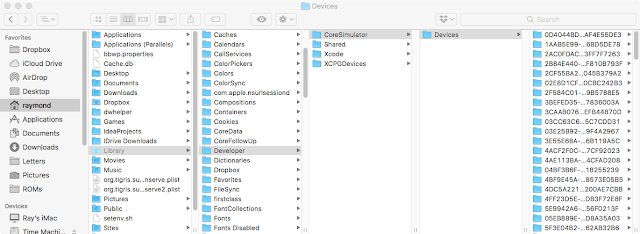Core Data abstracts a lot of the low level details of storage away for programmers, and that’s a good thing however sometimes it’s useful to lift the lid and see what’s happening beneath. For this post I’ll be specifically looking at the SQLite persistent store, I’ll assume you already have an app using Core Data and want to glean more insight into the inner workings. Fortunately the mac comes with a command utility to open and explore sqlite databases (sqlite3), but before we can delve into the database file, we must first find the file.
Finding the database file for an iOS App
The easiest way to look inside the database file is by running your app within the iOS Simulator for Xcode. The simulator stores all of its file structure within a directory on your mac. The trick is finding it. By default the simulator will store its files in Home Directory ▷ Library ▷ Developer ▷ CoreSimulator ▷ Devices. Normally the Library folder is hidden to prevent users mucking things up, however you can access Library from the Go menu in Finder by holding the option key down while displaying the menu.
However since we’re starting to perform some advanced techniques it may be easier to perform these actions on the command line, therefore open Terminal and type the following to perform a search of all the simulator devices for a file with a given name (you can substitute the file name for your own):
However since we’re starting to perform some advanced techniques it may be easier to perform these actions on the command line, therefore open Terminal and type the following to perform a search of all the simulator devices for a file with a given name (you can substitute the file name for your own):
find ~/Library/Developer/CoreSimulator/Devices -name CoreDataDemo.sqlite
This will print a list of all the files found with the given name. However if you have been running your app on multiple simulators then multiple files will be displayed. It may not be obvious which file is for which simulator as the folders are named after the device identifier rather than a human readable name, additionally the files are not sorted therefore the first file may not be the most recent one.
To find out the Identifier for the simulated device, we can get it in Xcode by going to the Windows menu and selecting Devices and Simulators. This will open a new window, switch tabs to Simulators and select the simulator that your interested in. The Identifier will be displayed along with the summary information.
Since this can be rather painstaking, I've written as script that will search for a given database file and display the top 5 most recently modified files and the ability to directly open them. As well as listing a human understandable version of the simulator. The findcoredata.py script can be found on GitHub.
You’ll notice that the sqlite database file may not be alone. You may also have a file with ‘wal’ suffix, this is the Write-ahead log and a file with ‘shm’ for the Shared-Memory file. If you intend to copy the database then it is important that you copy these files also.
You’ll notice that the sqlite database file may not be alone. You may also have a file with ‘wal’ suffix, this is the Write-ahead log and a file with ‘shm’ for the Shared-Memory file. If you intend to copy the database then it is important that you copy these files also.
Look, but don’t touch
It is important to remember that you should avoid making modifications to the sqlite data file as Core Data will manage that. The sqlite3 command line tool can be used to execute commands against the database.
Perhaps I'll blog more on the internal structure of the database, but for now since you know how to find and open the database happy exploration.
Perhaps I'll blog more on the internal structure of the database, but for now since you know how to find and open the database happy exploration.




